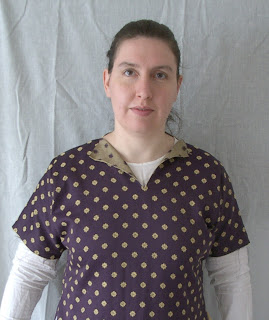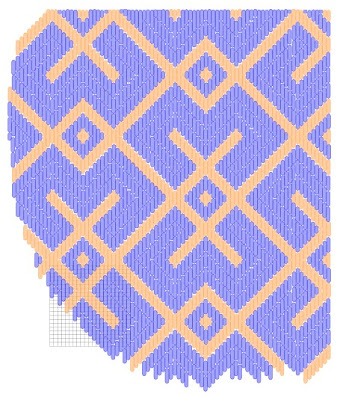Well I've sewn up all the construction seams on the garment and here's how it looks:
 In fact I've worn it to it's first event (with safety pinned hem), and danced in it, so I got a feel for how comfortable it was to move in. Of course then I wore it over a chemise, not my mundane clothes. (please ignore the silly faces, I dislike photos, and haven't the knack of doing poses yet.)
In fact I've worn it to it's first event (with safety pinned hem), and danced in it, so I got a feel for how comfortable it was to move in. Of course then I wore it over a chemise, not my mundane clothes. (please ignore the silly faces, I dislike photos, and haven't the knack of doing poses yet.)Lessons learnt
fabric stiffness
This fabric is very stiff, much stiffer than anything I've worked with before. (even the pvc, but that's got nothing to do with medieval sewing). But that's good because I expect some of the gold brocades available in period were very stiff, and so this may be more accurate for this style. Maybe. Any readers care to comment?

 Skirt width - with two gores was too wide. It was nice to dance in, but sat out quite stiffly, and as you can see in the photo, doesn't much look like the manuscripts.
Skirt width - with two gores was too wide. It was nice to dance in, but sat out quite stiffly, and as you can see in the photo, doesn't much look like the manuscripts.They might have had flowier fabric, but perhaps they just had narrower skirts - after all it saves fabric that way.
So here two pictures with the skirts pinned in narrower. The first uses only one pair of side gores rather than two. The second uses only half the width of one of those gores.
I think what is portrayed in the manuscripts, while it vary's a bit, falls between these points in general. Except the odd really skinny shirt which does look more like the second photo. At any rate I hate cutting down perfectly good gores, so I'm going to convert the skirts to one gore each side for this weekends bal d'argent (I do want enough width to dance too), and make a final decision about narrower or not later, when I'm ready to put on the hem trim.
skirt length
 I estimated skirt length based on the distance above the ground the hems appeared to sit in many illustrations, marked that on an existing garment and cut it that much shorter. And that is about the right length unbelted. But add a belt, flop the dress over the belt a bit, and it's much too high. I've seen one illustration this short, but only one (and I still think that one is a bit strange).
I estimated skirt length based on the distance above the ground the hems appeared to sit in many illustrations, marked that on an existing garment and cut it that much shorter. And that is about the right length unbelted. But add a belt, flop the dress over the belt a bit, and it's much too high. I've seen one illustration this short, but only one (and I still think that one is a bit strange).Investigating the manuscripts again, the majority are wearing belts , mostly with the dress flopped over the waist section of he belt, and only dangling ends showing or even just the fold in the dress showing. Look how much shorter the dress is. It's about twice the distance above the ground that I think is an average distance of a hem in this style. So if I had enough fabric to make this floor length, I'd expect the hem to sit where I want it when belted and puffed over the belt. This would be a very practical way of keeping your skirts clean (chemises would be easier to wash), so it's easy to see how this could originate as practical then transfer to fashion.
I do feel justified in using the shorter length dress though - there is at least one example that clearly is unbelted and has a dress that is shorter than the chemise and, annother that is less clear, but suggests no belt. And that was with just a quick check - I'm sure I'd find more in just the examples I've posted to this blog.
 Sleeves
SleevesI'm not happy with the sleeves. Firstly the bicep seam sits a bit far down the bicep. The photo below shows how the sleeves look hitched up at the shoulder a bit, so the bicep sleeve sits higher up. Compare with the ab
 ove photos. Actually I can't see the difference in the photos really, so I guess that makes me a perfectionist. No surprises there, but I'll shorten that upper sleeve panel when i get a chance.
ove photos. Actually I can't see the difference in the photos really, so I guess that makes me a perfectionist. No surprises there, but I'll shorten that upper sleeve panel when i get a chance.The lower sleeves are also being a problem. I think the flare at the top of the sleeve is not working in such a stiff fabric. I experimented with halving the width of the flare, and I like the effect better in this stiff fabric(See photo with narrowest skirt). Maybe I'll play with belled sleeves again next time I use silk or fine wool.
postscript - after bal d'argent:
wear testing
Well the skirt width worked ok. The flared sleeves were occasionally awkward during the English country dances, but then flared sleeves always are - that's what happens when you wear clothing from 400 years earlier than the dances. The dress looked good, I felt more prettified up. I didn't get time to work on the sleeves, so I still have to do that.
Also decoration - others might not be able to see how the dress looks far too plain still without all it's trim, but I can. Compare with this picture, which is one of my main inspirations for decoration locations. It might be time to start sewing on some decoration now that I know the body panels aren't changing, even if the sleeves still need work. At least that is handsewing work - it might get done a lot earlier than macine sewing work with me, because I can just work on it for 10 minutes.














































